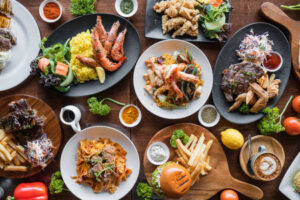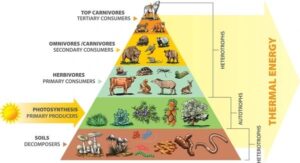Food Technology That Accelerates Food Production

Food technology refers to a mixture of “food” as well as “technology.” If we think of the industries that are connected to food, many people imagine things such as food processing and manufacturing, as well as food establishments. For a long time, these sectors have often been viewed as largely unrelated to modern technology. In reality, they are now excellent areas of application for technological advancements, including ICT robotics, robotics, and biotechnology. Each day, businesses are constantly introducing new technologies to boost the efficiency of production as well as to create functional food items that streamline consumption and distribution, respond to the changing requirements of the consumer, and even eliminate labour shortages. One of the main factors that have brought food technology up to speed is the development of technologies to classify ingredients and food technology as industrial items built on technology and science. The food we purchase in the grocery store is mostly made by industrial processes. Agricultural raw materials, like grains, are processed through a variety of stages before being offered as food. Through the process, it is changed in terms of physical, chemical, and microbiological. This is why food technology is a multidisciplinary engineering science. The bachelor’s program in food technology gives students instruction in the field of food engineering on a scholarly basis. The whole process of food production (“From Farm to Fork”) is examined from a technical, technological, scientific, and economic standpoint. A large portion of food processed in the food sector is life. Naturally, every product is unique and has an environment that alters as time passes.
Because of this, unlike electronic devices or automobiles that can be mass-produced and standardized stably, it was a challenge for producers to deal with these products, since their growth and production were not precisely monitored. As an example, robotics were not able to complete tasks that humans would be able to do, for example, grasping and placing uneven, soft strawberries. Innovations in Information Processing Technologies like artificial intelligence (AI) that uncovers relevant trends in diverse types of individuals, technology like the Internet of Things (IoT) that allows us to analyse and understand personal differences, as well as biotechnology, which enables us to regulate and monitor the characteristics of animals, as well as plants, have allowed us to adopt a new method of industrialising food technology. Furthermore, the massive size and continued growth of the food and beverage industry can be a reason for the increasing focus on food technology. As per the Policy Research Institute, Ministry of Agriculture, Forestry and Fisheries The global market for food and beverages is projected to expand 1.5 times over time, going from 890 trillion yen in the year 2015 up to 1,360 trillion yen by the year 2030. Since the market for applications is enormous and likely to continue growing, it is a great opportunity to put a lot of money into developing technology that can solve the problems that exist in the market, and create value. A few countries have implemented guidelines that promote food technology as an industry that is growing. In Japan, the Council for Public-Private Partnership in Food Technology was created in 2020 by the Japanese government, in conjunction with academics, industry, and the government to encourage innovative solutions for food technology and other initiatives.
Utilizing Food Technology to Try and Eliminate Food Crises and Losses

What kind of technology is used to address the social problems related to food and create value? Here is a list of projects in two common regions. In the first, there are measures for tackling hunger crises. By 2050, the planet’s global population is predicted to increase by around 30% from what it is currently. There is no doubt that food technology demand is expected to increase with this. There are also fears that climate change as a result of global warming could make it difficult to grow crops in locations that are suitable for growing. As part of the SDGs, the second one is to achieve “zero hunger.” To address the problems Biotechnology is used in the development of cultured meats through layers of animal cells before creating them using 3D printers to design cultivars that thrive in difficult conditions, with high yields.
Innovative techniques for fisheries and agriculture, including plant factories as well as onshore fisheries with artificial growth environments, are currently being put into application. Through the expansion of these techniques and methods, we’re not just growing yields but unlocking the power inherent in the genes of plants and animals to create foods with several ingredients that can be effective in improving the health of humans. Second, we can eliminate the problem of food waste.
Food Technology and Agriculture Organization of the United Nations

Approximately one-third of foods that are part of food technology, from the production of agricultural products to consumption, are wasted due to a myriad of reasons. This amounts to around 1.3 billion metric tonnes annually. In Japan in particular, where the quality of food is a major concern and a common commercial practice that encourages losses because of the “one-third rule.” According to this principle, the delivery- and sell-by dates are defined by dividing the duration beginning with the production date and ending at the date of expiration by three, which means that the item is removed after every period. The Japanese government is working on a solution to the procedure. The SDGs are also a set of goals to reduce food waste by half per person at the consumer and retail levels, as well as decrease food loss within the supply chain, the production process, and post-harvest losses in 2030. Modern food chain management that makes use of RFID tags, as well as the Internet of Things, is crucial to reducing the problem of food loss. It is the goal to be aware of the chain’s distribution patterns for food products and enable it to react to changes in the product’s condition by making it the raw material used in processing food items when the date for the best-by of food technology is approaching. If these techniques are used, it will also be possible to create traceability, which will ensure the safety of food by preventing fraud about the place of origin as well as tracking foreign chemicals, which include allergens, additives, and halal compliance.
Food Service Sustainable Dining
]]>What Is a Full-Service Food Place?

To categorize the categories of food places in this manner, there are three types of service: fast service, full-service, and casual fast. Full-service food places (FSRs) offer customers table providers and have a team of servers who take orders and supply meals. Restaurants that provide short-provider (QSR) services provide counter-provider or force-via services with pressure-through providers most effectively. Fast casual food places are situated between quick and full service. In recent years, the distinction between fast casuals, quick service restaurants, and fast casuals has become fuzzy. The spread of the pandemic as well as the shortage of staff have altered how many eateries approach their services. Delivery-only, mobile-order-and-pay and robot servers are some of the techniques being employed by restaurants that were previously full-service. While you are reading about typical restaurant models, be aware that how you handle and serve is entirely dependent on you. There are exclusive varieties of food places, starting from family-run restaurants to high-end connoisseur institutions. We’ll look at 12 of the most well-known sorts of food places and then discuss what is unique about them. Fast food eateries are among the first quick-service restaurants. Within the business, they tend to be called QSRs. One of the main characteristics of fast-food companies is that their menu is prepared quickly, typically in just a few minutes. The majority of the ingredients are cooked or frozen and need only to be warmed up. The food is served in disposable and takeout containers. The mass-produced style of food is referred to as “fast food.”.
Why open a fast food place?

Fast food establishments offer the best profitability margins of every type of food placed in our top 10 list. It is possible to avoid expenses such as flatware and tableware that are associated with dining in full-service restaurants. Fast food kitchens depend on a few pieces of equipment that include microwaves, deep fryers, and grills with flat tops, which means it is possible to avoid expensive repairs and equipment. Additionally, a lot of fast-food establishments are franchises or chains that allow you to profit from the existing brand’s power while avoiding the expense of advertising. These are the most common traits of fast-food restaurants:
- Service Type: Counter service or drive-thru services
- Menu A limited menu such as sandwiches, burgers, soft drinks and fries
- Interior: casual, practical dining areas that are easy to keep clean
- Examples: Burger King, McDonald’s, Taco Bell
- Price $
Casual restaurants offer full-service food places where customers are taken to their tables and served by servers. However, unlike formal dining establishments, informal restaurants offer spacious chairs, comfortable seating, and an informal ambiance. Menus include comfort foods as well as things that have proven authentic. It is not possible to find innovative cuisine or trendy décor in a casual eatery. Mom-and-pops, diners, and a lot of popular chain restaurants are regarded as relaxed dining places. Restaurants that serve casual dining account for more than 30% of the US portion of the market, which makes them among the most well-known types of restaurants. The menus are reasonably priced, and special offers like Happy Hour deals and coupon promotions are routine. Accessibility and affordability make informal eateries attractive to families with children. There’s a good chance of seeing tables changing fast at an informal restaurant. This can lead to higher profits. These characteristics can be expected at a casual dining establishment:
- Service Style: Full service
- Menu Menu items from the classic menu, such as comfort food and huge portions
- Interior: neutral decor, comfortable booth seating
- Examples: Olive Garden, Red Lobster, and Applebee’s
- Price $$
Fast-casual food places offer the fast service offered by a fast-food establishment with a broader selection of healthy, more natural food choices. The build-your-own menu is a popular fast-casual idea, offering sandwiches, wraps, or burritos that are made according to your orders. Payment, ordering, and food delivery are done at the counter. The self-service coffee and beverage stations are typical. Fast casuals can provide only table service, delivering orders, but with a service staff that is not available.
Why open a food place?
There’s an increasing number of fast-casual eateries that cater to customers looking for an easy snack that’s better than fast food and cheaper than sit-down casual eateries. These kinds of establishments have a high volume; however, they have fewer employees as compared to a restaurant that is full service. This money saved on the cost of labor can be utilized for items like menu ingredients, advertising, or maintenance of the building. Fast-casual restaurants are also able to provide guests with a mix of food options that are on and off the premises. Fast-casual food places typically include the following features:
- Service Style: counter service or restricted table service
- Menu Subs, sandwiches salads, wraps, or burritos
- Interior: modern but informal
- Examples: Panera Bread, Chipotle, Sweetgreen
- Price $-$$
Contemporary casual restaurants provide tables for dining at a table, similar to a typical restaurant However, they are outfitted with the look of upscale restaurants, with a modern menu as well as stunning interiors. A lot of contemporary eateries offer global or fusion food as well as vegan and gluten-free choices and environmentally friendly techniques. The upscale casual eateries are privately owned or are part of a smaller chain in a regional area. If you are a young person, modern casual restaurants are typically a great option when going out for dinner. If you’re looking for a fashionable hotspot that is affordable for numerous diners, an upscale casual eatery is an ideal choice to consider. They offer a classy appearance and an excellent menu, which is less expensive than fine food places. The style of restaurants allows the diner to experiment with the latest trends in food and sample diverse cuisines. Additionally, it also allows you to show your creative side through the tables and decor of your restaurant. It’s not a good idea to employ expensive, mismatched dishes in casual restaurants However, it’s acceptable to be modern in an environment with diners taking pictures across the table.
- Service Style table service mobile order-and-pay service, QR codes menus
- Menu: trendy cuisine, farm-to-table, global flavours, diet-inclusive options
- Interior A thoughtful, lively interior design that pops when you take a picture
- Examples: Seasons 52, Earls Kitchen + Bar, Iron Hill Brewery
- Price $$-$$$
The finest food place Establishments such as Michelin-starred eateries have the highest place when it comes to price and formality. The manner of dining in high-end dining is a tradition of the past with various rules and variations. There are a few extra details that aren’t found in other types of establishments, such as when servers “crumbs” at the table to clean any food particles from the tablecloth. The guests must be dressed appropriately when dining at a high-end restaurant. It gives dining at fine restaurants the feel of a private dining experience and makes it a special treat that is reserved for special occasions, for example, an anniversary, the birthday of a loved one, or the occasion of a wedding. The menus for fine dining include items that aren’t something you would eat every day, such as caviar, steak tartare, or foie gras. Cafes and coffee shops hold their spot in the hearts of a lot of consumers. They’re usually associated with certain routines, such as buying the morning cup of coffee while driving to work and catching up with friends to talk while waiting for the arrival of a loved seasonal beverage. Many cafes have co-working areas as well, which means those who are not in the office can drink the coffee they love as they work on laptops. Coffee shops and cafes offer an extensive menu of drinks that is focused on tea and coffee; however, they might also feature an assortment of bakery items and serve a smaller, simpler breakfast as well as lunch options.
Why open a coffee shop?

The expense of creating a tiny cafe is much less expensive than that of a restaurant with full service, which means you do not need to have a staff of many. Demand for coffee with a special flavour continues to increase, and the price of the coffee market is quite high. Specialty drinks like coffee or blended drinks could be priced as high as 80%, which means you’ll earn a substantial profit. Cafés and coffee shops possess boutiques that specialize in drinks like bubbly tea, smoothies, or even fresh juices, which are becoming increasingly popular and widely available. The market for beverages is expanding, and coffee and tea aren’t just the drinks that get the spotlight anymore. Smoothies and bubble tea stores offer a variety of customisable drink options, with numerous varieties, toppings, and additional ingredients to pick from. The majority of these food places are located in smaller spaces with limited seating. Customers order their food at the counter. Drinks are served using special drink equipment. Like tea and coffee at the same time, the markups on special drinks can be very expensive. It is expensive to invest in opening a juice shop or smoothie bar, which is much lower than for a full-service restaurant. There are franchise opportunities that let you profit from an established business model. The following category of restaurant we’ve included in our listing is an all-you-can-eat buffet. Buffet restaurants operate differently from other restaurants. There is no menu available; they are distinguished by self-serve buffets, meaning customers can eat however many times they want for a fixed cost. Instead of cooking meals on the spot, buffet cooks create large portions of meals that can be served in buffets or hot food stands. As a result, it is not possible to find delicate food items in buffets. You will, however, discover a wide selection of food items that can fill people up fast. As buffets offer plenty of food and places to eat, it’s difficult to comprehend how they make profits. The truth is that buffets are operating on a tiny margin. This means that much of every sale is used to cover the food costs. When you are planning to open a buffet, managing your food costs will be an issue. However, these kinds of establishments compensate for the higher costs of food ingredients in different ways. Buffet restaurants operate with only a small number of employees; generally, only two cooks are responsible for the preparation of meals. Buffets also rely on quantity to earn money. Some restaurants allow hundreds of patrons. Each day, sales increase because foot traffic is that high.
Food Trucks
Food trucks began as a fashion; however, they’ve evolved into an integral part of the food service industry. What’s not to like about mobile eateries, which can serve food items that are popular in food places, occasions, parks, or even homes? Food trucks are kitchens with wheels. They serve a limited menu, which usually concentrates on one kind of cuisine; however, they manage this perfectly. Customers can order their food and pay at the counter and then collect their food once it’s cooked. Fast food truck operators may employ orders and payments made via mobile or online to make their services more efficient. If you’re eager to begin your career in food service there are plenty of advantages to creating your truck for food. Smaller kitchens, smaller equipment, and the absence of workers make food trucks a more affordable investment than many different types of eateries. Food trucks also provide a means to try out your idea and menu before opening the doors to a full-service restaurant. Sometimes, they are left off the menu of types of food places concession stands, and snack bars that make for profitable food service establishments. The typical concession stand takes up a small area and is small enough to accommodate the counter for service, a few small pieces of equipment and, occasionally an unassuming kitchen. Certain concessions are made up of mobile kiosks or carts that are run by a single individual serving customers as well as preparing orders. There are concession stands in the ballparks, theatres, and amusement parks. Festivals, boardwalks, as well as outdoor festivals are ideal locations to sell concessions. The price of the creation of concession stands is less than that of a food truck. An investment of just a few dollars and a cost-effective concession make a great first venture or a side business. It is possible to start by utilising a table that folds along with a few pieces that comprise the concession apparatus. Machines for popcorn, snow cone machines, and hot dog rollers can be affordable and allow the owner to earn money from the most popular snacks. Pop-up eateries Bars, restaurants, and stands are an emerging way of doing business that permits proprietors, chefs, and guests to test different concepts in food and dining. Pop-up businesses are temporary spaces that serve food for a brief time and test a menu. A few pop-ups still follow the same procedure to “pop up” for events or even on a regular monthly basis. Other pop-ups develop into businesses of a larger size, including bars, food trucks, or even sit-down eateries. A pop-up store is similar to taking a dip in the sea of food service. The concept doesn’t need the same commitment as a brick-and-mortar establishment, but it lets users experiment with the concept and see how it performs. If you’ve not run any kind of restaurant previously, pop-ups are an excellent way to test whether you’ve got the necessary skills. Then, you can iron through the wrinkles using an open-air event, and when the numbers are increasing and you’re looking to move your restaurant to the next step and grow, you could become an entirely different kind of restaurant. Ghost restaurants are also known as virtual brands or ghost kitchens. A ghost restaurant, or a virtual or ghost kitchen brand, is an establishment with no physical location. In essence, a ghost restaurant has an open kitchen. The sales process is done online, and food orders are generally shipped. No interaction with guests is permitted within the premises. The kind of food places you would like to begin with will affect your concept, your branding, and your universal approach to business. Each brand is likely to have its menu and identity however, inside the kitchen of the ghost the food items are made together. Pete’s Pizza and Tina’s Tacos seem to be two distinct establishments with separate websites, but menus for both are cooked at the same time in the satellite kitchen. If you compare the costs of opening a kitchen that is ghostly against a full-service model restaurant, you’ll reduce costs in various aspects. The absence of a storefront implies that the space requirements for your restaurant are less, and the cost of rent and utilities will reflect this. There will be no front-of-house personnel and no furniture for the dining area or outdoor signage. But you’ll require investment in the digital aspect of your business through your website, social platforms, and third-party delivery companies. Delivery services are expected to increase, making the ghost kitchen an ideal business idea for the right businessman. The following characteristics in common characterize ghost kitchens: As the food service industry continues to grow, innovative solutions to food service challenges are producing new business concepts. There are more types of food places than ever before, and there are a variety of opportunities for those who want to break into the industry. Start small with a concession stand, food truck, or pop-up food place, and grow your business into something large over time.
Food Panda Craving Satisfaction
]]>What is Food Panda?

Food Panda can be described as an online food delivery and ordering platform that connects consumers with restaurants in their area. With user-friendly platforms that make searching menus on various websites simple, ordering delicious dishes for affordable prices becomes possible, and delicious cuisine can be purchased with just the click of a smartphone screen! Foodpanda company models can leave companies feeling confused. There can be various concerns surrounding its operations, such as, for example, what its ways are of generating revenue or any potential benefits it could bring them. Questions remain. Visit this post for a thorough understanding of food delivery and ordering platforms. Most companies utilize apps on demand that enable them to meet customers’ growing expectations more easily. Food apps have long been part of the on-demand economy. Their simple psychological appeal attracts users while providing time and effort savings. The food delivery revenue sector is expected to see considerable expansion, with an eventual market valuation of approximately US$1.02 trillion by 2024. Food Panda and similar apps will play an increasingly vital role in helping us save both effort and time in 2024, offering customers convenience across their touchpoints with their on-demand service. We will gain insight into this vast food industry company to gain a clear view of its revenue model and business strategies.
Success Story Of Food Panda In the Food Business
Food Panda is an international online food delivery platform present in over fifty countries worldwide, including Bulgaria, Asia Pacific, and Romania. Managed by German company Delivery Hero SE with offices based out of Berlin, Foodpanda offers food delivery anywhere in its service areas. Foodpanda provides foodies with an effortless platform for ordering their favourite meals from local eateries across 246 cities worldwide, offering over 15,000 restaurants as partners on its platform. Foodpanda partners with over an estimated 80,000 riders for delivery. Deliver Hero acquired its business in December 2016. In India, Ola acquired Foodpanda operations for between $40 and $50 million on December 29th, 2017. Food Panda sold their Delivery Club division for $100 million to mail.ru in Russia in 2016, while Rocket Internet, their biggest shareholder, sold Foodpanda to German rival Delivery Hero and adopted their logo of pink instead of orange in 2017, respectively. Tech major Delivery Hero promptly followed Foodpanda into rebranding itself, offering exclusive discounts and promotions designed to increase customers using its platform. By 2018, Foodpanda had processed around three lakh orders each day, while this figure rose to over five lakh by 2019 alone. Ola is suspending Foodpanda food delivery service this year and has laid off more than 1500 “food delivery executives.” Food Panda operates under its in-house brands known as cloud kitchens, an idea adopted by Ola when purchasing Holachef in 2018. In 2019, their business will only include three private labels within this sector, such as The Great Khichd Experiment and FLRT. Foodpanda has raised $318 million in venture capital funding over its history. Foodpanda successfully raised an initial round of financing through Rocket Internet, AB Kinnevik, Phenomen Ventures, and MENA Holdings in 2013. That year also marked when Phenomen Ventures made an $8 million investment in Foodpand. That same year, its investors and Phenomen Ventures each invested $20 million, respectively, in an initial round. By 2014, Foodpanda announced they had amassed $60 million across various investor pools by 2015, while Goldman Sachs announced investing $100 million in Foodpanda during a short period! Foodpanda’s founders were Luke Nagel and Rico Wyder, who established it in 2012 in Berlin, Germany, with headquarters nearby. Foodpanda now stands at $6 billion+, while funding comes from Rocket Internet as well as other investors totaling $100 million in capital funding. Statista reports indicate that Food Panda received approximately 8.7 million orders during its inaugural year alone in 2014. By 2015’s end, however, they had managed to process over 22 million.
How Does Food Panda Work?

Food Panda is an exciting platform that facilitates restaurants offering excellent services directly to patrons who would prefer delivery of their meals directly to their homes. Foodpanda makes money through delivery costs while simultaneously cutting its operating costs through different strategies, which include:
- Special discounts may apply when making bulk purchases
- Creating stronger networks to ensure timely food deliveries
- Collecting cash before delivery and advertising fees
- Deliver different kinds of items beyond food delivery
Foodpanda has received much media coverage due to its focus on each of the phrases listed above, especially as on-demand apps have come into focus over recent years. More businesses have decided to invest in service on demand, with plans such as creating their own advanced Food Panda replica application to offer customers effortless food deliveries at all hours. Check out this video of Foodpanda’s process of providing timely deliveries of meals directly to customers’ doors! Food lovers can browse the menus of nearby restaurants as well as their specialty dishes and meals. Customers place orders with them, who in turn give orders directly to restaurants, who then prepare and cook food and prepare delivery service providers accordingly for delivery service providers to deliver it directly. Eventually, it takes over by giving orders directly to delivery service providers, who then distribute orders directly. Our delivery service delivers food directly to our clients’ addresses, while phase 5 paying customers make payments and provide feedback based on their experience with it. Foodbanda provides simple and dependable operation of Foodpanda-esque applications like Foodpanda for those passionate about food or restaurants alike. If your business requires long-term development strategies to thrive, then consider investing in similar apps as a possible way forward. Foodpanda Business Model Canvas For food lovers everywhere, Foodpanda provides an exquisite and flavorful dining experience like no other. Their platform has effectively eliminated the necessity to travel to restaurants since foodies can get it delivered directly to their homes via ordering food online. Food Panda links them directly with nearby restaurant options they prefer and connects customers directly. Learn everything there is to know about what the system does as well as their business model today. Don’t wait; learn it right now. Foodpanda provides customers with delicious, nutritious, and exceptional dining experiences; there is no need to go anywhere for meals anymore, all thanks to an online ordering system connecting eateries directly with nearby restaurants of their preferred choice. Discover everything this system does and its business model within just minutes.
Consumer Groups

Food Panda provides significant value proposition advantages to its platform users: access, convenience, personalisation of branding status as a brand status savings and cost reductions. Foodpanda makes advertising products to those unable to visit an actual physical location simpler while making shopping online simpler for food shops themselves. Customers can place orders using an easy and intuitive system; they can make orders any time of the day via the site without hassle or issues; additionally, they have the choice of picking up or having items delivered right to them; and they can pay using any method suitable to them. The system allows customers to customize the experience by categorizing restaurants according to type. Furthermore, its offers, such as food discounts and free delivery, encourage customer interaction as they try new products while saving costs. Foodpanda has earned itself an exceptional reputation thanks to its rapid business expansion, currently covering around 500 cities in 24 different countries and receiving accolades such as winning the European Tech Startup Award 2014 in “Best E-commerce Startup.” Foodpanda operates with a cost-driven model to maximize sales at its stores while simultaneously decreasing expenditures and expenses, both manually and via automated systems. Primary drivers for expenditure on this website include marketing and sales expenses as well as fixed expenditures such as customer support and administration charges or administrative overhead fees. Foodpanda derives its primary income stream from restaurant commissions it has established through partnerships. According to one report, over 40% of Foodpanda’s revenue comes through delivery, and 10% comes through advertising. There are multiple other avenues through which Foodpanda generates funds; explore for yourself. Digitalization has led to an explosion of food delivery right to our homes, turning dining out into more of an at-home dining experience than ever. Modern-day foodies prefer customised meal delivery services at home, such as Food Panda, that remove the hassles associated with managing and finding delivery companies. Foodpanda turns around $100 into $150 when signing up, and Foodpanda offers businesses an advertising service through which they can market their business through an interactive site such as its platform. Businesses pay monthly advertising fees on Food Panda to take part. Foodpanda charges an applicable delivery charge on each ordered shipment that depends upon its area. Users visiting Foodpanda’s app or website will see payment options like credit or debit cards as well as methods of making payments available via any number of platforms, such as credit, debit, F&I cards, etc., making payments more flexible. Foodpanda charges an affiliate revenue source fee from both banks offering these payment services directly, which provides another avenue of income generation for Foodpanda. Foodpanda promises around 20% commission for orders users place through its platform, saving restaurants time and money by not covering electric bills, rent costs, and other related service-related costs for service delivery, yielding substantial profits for Foodpanda service providers. Food Panda may have experienced various obstacles along its journey as an online delivery platform, yet they have managed to overcome all challenges to remain viable. Their rapid expansion can be traced to customers preferring online services over physical ones; similarly, their platform gives users seamless customer service by offering direct deliveries directly to users’ homes; they also have a large market presence as a large audience subscribes; and additionally, you could create sophisticated delivery platforms within organisations too.
Food Chain from Farm to Fork
]]>What is a food chain?

A food chain refers to an ecological process in which living things consume each other before being devoured by larger organisms. Energy and nutrients flow across species at various trophic levels in an ecosystem in a manner known as a “feedback loop.”. Trophic levels refer to various stages in this chain, beginning from producers at its base up to primary, secondary, and third consumers; each stage is known as a trophic stage in this food chain. A food chain comprises several main parts. Producers are autotrophs like phytoplankton, cyanobacteria, algae, and green plants that generate food through photosynthesis using solar energy for fuel. These producers form their foundation by using sunlight’s power to make food from nothing! Producers may include any organism, plant, or animal that utilizes photosynthesis for its sustenance needs, with organisms being autotrophs due to producing what they consume via photosynthesis being considered producers in general terms. Consumers refer to organisms that rely on other living organisms or plants for sustenance. A food web comprises almost all living creatures, as consumers rely heavily on each other as food sources. Consumers include herbivores that consume plants, carnivores who feed on other species for sustenance, parasites who inhabit certain organisms to harm them, and parasites who reside on certain individuals to harm them, as well as scavengers who consume decomposing carcasses after creatures have passed on, plus scavengers who consume deceased animal carcasses from consumption by other consumers—an integral component of any food web! Herbivores in this case can be considered primary consumers, while carnivores represent second-tier consumers. Both species inhabiting the second trophic layer consume producers. Therefore, herbivores, or primary consumers, include people residing within that second layer. Decomposers, organisms that derive strength from waste or lifeless natural material, represent the very last degree inside the meal chain. Decomposers play a necessary role in offering critical nutrients to soil by breaking down organic fabric into inorganic materials, which provide critical nourishment to soil ecosystems. Decomposers play an essential part in recycling substances they ingest by returning minerals into oceans or soil, where producers or autotrophs may utilize them in turn, starting a fresh food chain that extends across multiple food chains within an interlinked food web. Food webs resemble chains of food in that both consist of interlinked species eating each other; in some instances, an individual species might even be consumed by multiple predators or by multiple other species; this explains why so much of tropical biodiversity lies within one system. Food chains don’t accurately demonstrate energy flow. In contrast, the food web provides the right visualization as it shows interactions among species. With more interrelationships between various food chains forming their structure and becoming increasingly complicated over time,. Such complexity could ultimately contribute to an ecologically sustainable system.
Food Chain Integrity

Integrity is multifaceted when considering food supply chains from producer to consumer, from producers through all stages. Modern food chain integrity measures centre around factors including the microbiological and chemical safety of foodstuffs as well as source integrity (authenticity of source), fraud detection, and quality assessments. Sooner or later, customers will expect products to meet more stringent eco-friendly, animal welfare-oriented, no-child labor-free criteria, as well as trade with emerging nations’ standards for the production of high-integrity food. Food businesses must transform such consumer sentiments into objective standards for producing food with integrity. Detritus Food ChainThe detritus food chain includes various living organisms as well as plant species like algae, bacteria, and fungi, as well as protozoa and insect mites, among others. Decomposers begin feeding off dead organic matter; energy from food then gets converted to decomposers, which in turn become food sources for detritivores and decomposers, which later feed carnivorous organisms such as maggots, which become food for larger carnivorous organisms such as snakes, frogs, etc. Primary consumers include protozoans Fungi bacteria, among others, feed off decayed organic debris, while other consumers include protozoans Fungi feed off decayed material that feeds off debris before moving back upstream again into food chains that begin. One type of food chain known as food chain grazing begins with green plants and then moves on through herbivores before becoming carnivorous. With such an ecosystem in place, energy for photosynthesis becomes limited at the foundational levels of food chains, grazing or otherwise. At the root of it all lies the energy exchange between herbivores and autotrophs; from here, energy can travel back down through this food chain until reaching herbivores again for consumption. As autotrophs form the basis of nearly all ecosystems on Earth, most food chains worldwide follow this particular model of sustenance distribution. Such chains facilitate both local and international commerce through complex flows. Supply and exchange chains may both play an integral part. Regulations enforced by intergovernmental bodies provide structure for this market, while social input raises standards through private industry participation. As part of global trade in food chains, small farmers cannot participate in large portions of production both globally and locally. To illustrate its complexity in India, the United States is shown as a component in this chain. Humans play various roles within a food chain depending on what they consume as sustenance. If humans only eat plants as sustenance, then their role as primary consumers would be clear; otherwise, they are called secondary or omnivore consumers, respectively. Animals too are consumers in food chains since they consume both plants and other animals that consume plants in one way or another as consumers, producers make food, consumers eat it up before it finally ends with predators taking it all down through one continuous pathway into energy flow pathways of various sorts (in food chains it all starts from producers making food production to being eaten upstream of producers by producers making food production all the way up until topmost predators at last) where energy flows down one path while food webs present multiple energy flow paths between organisms eating multiple items consuming an organism consumes multiple items, unlike food chains where energy flows one way only through one path for energy flow while one way flow exists between producers producing energy flow pathways from one stage of energy flow while there can be multiple paths through which energy flows between various organisms in that particular chain or web structure where energy flow follows one path), one path than another when considering energy flow within this complex system of course.
Farm-to-Market Food Chain
A food chain refers to the complex distribution system for both locally produced food items as well as international supplies of them and serves both as supply and value chains. Many regulations imposed by international organizations act as the foundation for these markets. Social contributions also raise standards by engaging the private sector. Unfortunately, global trade within food supply chains kept small-scale farmers out of much of global production as well as local markets. To demonstrate the complexity of food chains in both India and America, different components from both chains have been displayed here. Strong top-down influence can result in cascading cascades of trophic elements within these food chains. One of the best-studied food chains can be found in mid-latitude lakes, where researchers have conducted extensive food chain analyses. Zooplankton and phytoplankton serve as key links between plants and herbivores, providing crucial food. These large zooplankton lakes remove phytoplankton from water at an extremely rapid pace, making them one of the world’s biggest herbivores. Lakes that contain only low concentrations of planktivorous fish tend to experience lower phytoplankton densities due to the large species of zooplankton that thrive at such conditions, significantly diminishing phytoplankton populations during the midsummer months and becoming clear. Planktivorous fish provide enough planktivorous to reduce zooplankton numbers in lakes that contain enough planktivores that consume it, mitigating any negative impacts from phytoplankton-zooplankton interactions in the summer months. Consequentially, water becomes opaque with phytoplankton blooms during that season, creating an “upward cascade of planktivores to phytoplankton.” Lakes with large piscivorous species like wall-eyed pike extend four links in their chain, and planktivorous fish populations decrease, freeing Zooplankton populations from predation. Knowledge of food chains is vitally important because it reveals intricate relationships within an ecosystem, how organisms rely on each other for survival, and how energy moves within this system. Understanding food chains helps reveal these complex interrelations as they illustrate energy flow within it and thus show us where resources lie in an ecosphere.
Food Network Grill Master Unleashed
]]>Buckwheat Food Network

Although only five or six millennia old, buckwheat has managed to become one of the hottest trends this season as one of its main ingredients. It resembles seeds in appearance but remains simple enough that many consider it beautiful enough. Buckwheat lovers have fallen for its delicious nutty flavor and are increasingly using it in soups, pasta dishes, and baked goods such as brownies, waffles, cookies, and cakes. This has prompted an unprecedented revival in grain production that’s anticipated to increase by between $457 and $6 billion by 2027. Nostalgia may play a factor here. “People may recall eating pancakes made with buckwheat with their grandparents, which may make the taste familiar and appealing,” notes Caroline Sluyter, Director of Food Network Programs at Whole Grains Council. Add variety to your breakfast menu with these delectable buckwheat-based offerings! Croissants may still be popular, but with 10 years since the Cronut Revolution had passed by, something needed a change. These days, croissants come in many distinctive flavours such as black truffle, ube, and prosciutto-asiago. Michel and Augustin offer inventive options with croissant chips made by them; croissant croutons available from Trader Joe’s are another hit, while mini croissant cereals created by @lappartement4f became an Instagram star! Are you searching for longer-lasting products than coffee breaks? Look no further—with Amazon, you now can. Lovers of pickles will find success this year as we now deliver gallon-size juice made with pickles as well as numerous items with pickle flavour directly to their doorstep! Pickle lovers will delight in trying Grillo’s Pickle de Gallo-flavored cotton sweets, pretzels, tortilla chips, and almonds that pair wonderfully with Best Maid Sour Pickle Beer. Pickles have led us towards more salty, sour-flavoured food due to the increase in popularity of fermented food networks like sauerkraut and kimchi – something that science has verified as a trend. Serotonin, which produces our feel-good hormone, can be generated through sour tastes; thus, these dishes should bring us happiness! For optimal drinking and food enjoyment, cheesemakers have joined with local wineries and breweries to produce unique varieties of traditional handmade cheeses that contain alcohol for an extra kick. “They’re creating new flavour profiles without reinventing how to produce them,” according to Rachel Perez of the American Cheese Society’s Board. Recent winners of this award include Vermont’s Jasper Hill Creamery’s Raclette-Style Cheddar washed with wine; Wisconsin Deer Creek Cheese’s Aged Cheddar Soaked in Chartreuse; and Oregon Rogue Creamery’s Soft Blue wrapped in Pear Brandy Soaked Grape Leaves—to name but three examples! Cheese sold at grocery stores has also caused quite a sensation, such as Murray’s Cheese at Kroger selling bourbon cheddar parm and Aldi selling cheddars created using Irish cream whisky, vodka liqueur, or whisky as ingredients. Be trendy by serving our three favourite recipes we tested here in our kitchen!
Food Network of Fishless Fish

Being elegant may be difficult at an age as ancient as 5–6 millennia old, yet buckwheat, an unassuming grain that resembles seeds, has come to become one of the season’s most prized ingredients. Buckwheat lovers have fallen head over heels for its deliciously nutty flavour, including adding it to soups, pasta dishes, and any batter-based recipes (brownies, waffles, cookies, or desserts). It has spurred an economic revival within the grain industry, projected to range between $457 and $6 billion up until 2027. Nostalgia may also play a part. Caroline Sluyter, Director of Food Network Programs for the Whole Grains Council, suggests this may be why so many consumers recall eating pancakes made with buckwheat with their grandparents as appealing flavours that they remember eating when young, according to Sluyter’s research. Mix up your breakfast menu by including delectable buckwheat-based items! Croissants may still be popular, but with over 10 years having passed since the Cronut Revolution took off, they wanted something new! These days, croissants come in an assortment of flavours including black truffle, ube, and prosciutto asiago. Always bringing exciting options, Michel and Augustin created croissant chips, croissant croutons from Trader Joe’s, and mini croissant cereals made available via @lappartement4f, providing new ways to snack. Are you searching for products longer than coffee crumbs? Well, fans of pickles may finally get what they are after this year: a gallon of juice from pickles as well as delicious gadgets featuring them are now readily available through Amazon! Pickle enthusiasts will delight in these pickle-flavoured cotton chocolates, pretzels, tortilla chips, and almonds all dipped into Grillo’s Pickle de Gallo for an exquisitely delicious pickle experience that pairs wonderfully with Best Maid Sour Pickle Beer. Pickles have contributed significantly to our demand for more salty and sour-flavored food since their growing popularity within fermented food networks like sauerkraut and kimchi production networks, including sauerkraut. Clinical studies have supported this trend. Serotonin, which increases our feelings of happiness, can be released through bitter tastes in food. Therefore, for optimal happiness-causing consumption and dining experiences, we need foods rich in bitter flavours to create them! Cheesemakers have collaborated with nearby wineries and breweries to craft creative versions of handmade cheeses to produce boozy cheese products with them! Rachel Perez, a board member of the American Cheese Society, states: “These innovators are creating exciting flavours without reinventing how to produce them.” Recent recipients of this prestigious award include Vermont’s Jasper Hill Creamery’s Raclette-Style Cheese that was washed with wine; an aged cheddar from Wisconsin Deer Creek Cheese doused with Chartreuse; as well as Oregon Rogue Creamery’s soft blue wrapped in pear brandy-soaked grape leaves for good measure. Cheeses found at grocery shops have created much excitement, including Murray’s Cheese at Kroger offering bourbon cheddar parm and Irish cream whisky made into cheddars that Aldi offers as part of its product offering. Bring modern trends to the table by serving any one of the three dishes we tested in our kitchens.
Food Network: Offering Chewy Treats

At Walmart, Piggly Wiggly, or Trader Joe’s, you will encounter mochi in various shapes and forms, from mochi balls filled with ice cream to tiny mochi that mimic marshmallows used in cake mix, plus much more. Mochi, originally found in Japan, is an elegant rice paste known for its subtle sweetness that may or may not have found its way onto grocery store shelves. Chances are you have run across mochi somewhere along your travels! Food Network Mochinut Mochinut is an American mochi doughnut chain offering their famed red velvet and pistachio Nutella versions and red velvet delights that may soon expand throughout the United States. As reported on Food Network, Mochidoki Ice Cream Company is expanding into grocery stores. Gummy rice flour gives mochi confections their distinctive suppleness and elasticity, which has become more widely recognized through tea bubbles, tapioca gummy pearls, boba, etc. That crunchiness has come to be known as QQ.” Kat Lieu’s book Modern Asian Baking at Home uses this idiomatic expression, loosely translated to mean that mochi and boba are delightful snacks to snack on! “Bouncy Taiwanese” describes these qualities perfectly. Desserts come in all colours and flavours, and eating one makes you feel like a kid again.” Take advantage of this new trend and create delicious desserts yourself. Tequila has quickly become the go-to American liquor, second only to vodka when measured by annual revenue. Kendall Jenner, Nick Jonas, and LeBron James all boast private label releases of Tequila as a testament to this trend. Rita Ora, Guy Fieri, and Sammy Hagar will partner to produce Santo Tequila; an alcohol made up of both Tequila and Mezquila components from mezcal. Dos Equis joined in on this trend recently by unveiling an ice-cold lime cocktail packaged together with Coca-Cola Paloma cocktails made by Fresca. Get involved by whipping up some delicious cocktails featuring tequila. There is always room for creativity when creating delectable treats; one such flavorful enhancement could include adding an array of vibrant flowers, such as the hibiscus flower. Our food network’s fascination lies with its brilliant red bloom and its sweet-tart allure. “Both your tasting experience and attire should be carefully considered at any event that everyone is watching,” advises Suzy Badaracco of Culinary Tides Inc. as head fashion forecaster. Since their introduction into cocktails and tea blends, citrusy or tart-tasting flowers have quickly become one of the most desired components. Google searches for beverages incorporating food network hibiscus have increased by two times year over year, and more chefs and cooks are adding this flavour to a wide array of meal objects, ranging from beverages and desserts to appetizers and entrees. Hibiscus can now be found regularly on restaurant menus, with its popularity having expanded by 24% in just the past couple of years. Easily available at grocery stores near your residence with curd, goat cheese, glowing water, or sorbet being just some examples that may contain this delicious red meal gadget containing vitamins C and antioxidants.